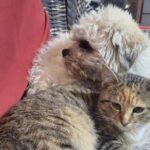
Declawing Cats
Declawing is a cruel surgical procedure to remove the last bone in a cat's toes.


Declawing is an invasive surgical operation in which the last bone of each toe is amputated — similar to severing a human finger at the last knuckle. The procedure is commonly performed for convenience rather than for the cat’s well-being. For example, many people have their cats declawed to prevent them from scratching furniture. Besides post-surgical pain and the inability to perform natural behaviors like scratching, there are other negative implications for well-being associated with declawing.
Declawing, or onychectomy, is a serious medical procedure where a cat’s third phalanges (toe bones) and claws are surgically removed. The American Veterinary Medical Association states it “should be regarded as major surgery.”

Support and Opposition for Declawing Bans
Support
The Centers for Disease Control and Prevention (CDC) does not support declawing cats. Its website outlines how ill and immune-compromised individuals can live safely with their companion cats and does not include declawing in its list of recommendations for reducing cat scratching. Instead, the CDC recommends avoiding rough play and trimming cats’ nails frequently. Furthermore, guidelines about living with HIV, jointly produced by the CDC, the National Institutes of Health, and the HIV Medicine Association of the Infectious Diseases Society of America, states “declawing is not advised.”
The American Association of Feline Practitioners (AAFP) strongly opposes declawing as an elective procedure, noting there are “inherent risks and complications with declawing that increase with age such as acute pain, infection, nerve trauma, as well as long term complications like lameness, behavioral problems, and chronic neuropathic pain.”
Opposition
Declawing is a lucrative procedure for veterinarians. Veterinary groups regularly use lobbyists to oppose legislation targeted at banning declawing.
The American Veterinary Medical Association (AVMA) — a national nonprofit organization for veterinarians — did not support legislative restrictions on declawing and instead encouraged veterinarians to educate clients about the “normal” scratching behavior of cats and concluded “the decision to declaw a cat should be made by the owners in consultation with their veterinarian.” But in 2020, the association semi-revised its policy, stating that it “encourages the use of alternatives but says professional judgment is key when making a decision as to whether to declaw a cat.”
There are extremely rare circumstances, such as cancer in the nailbed, in which declawing surgery is necessary. Virtually every declawing ban includes an exemption for this. It is not a logical argument for opposition groups to argue that declawing bans limit a veterinarian’s ability to treat their patients.
Medical and Behavioral Implications
A 2017 study published in the Journal of Feline Medicine and Surgery found that declawing has a detrimental effect on cats’ well-being. The study found:
- a clear association between declawing and the presence of deleterious side effects after the typical posoperative period in a comparitively large sample population.
- a significant increase in the odds of developing adverse behaviors, including biting, barbering, aggression, and inappropriate elimination, as well as signs of back pain, among declawed cats.
Complications from the surgery itself include “anesthetic complications, hemorrhage, infection and pain.” And after the recovery period, declawing can result in lifelong physical and behavioral problems. Declawing can cause permanent disability. Specifically, a declawed cat is at risk of pain in the paw, lameness, infection, dead tissue, nerve damage, bone spurs, and back pain. Cats are naturally digitigrades (meaning animals who walk on their toes). Declawing changes the way that a cat walks, and over time, this imbalance can also cause chronic pain. If the nail is not removed properly, it can regrow, an incredibly painful process for cats.
Since declawing inhibits a cat’s normal means of movement and defense, behavioral impacts can also result. Documented effects of declawing include interference with litterbox use. Other cats may resort to biting because they have been stripped of their primary defense mechanism. Declawing fundamentally hinders a cat’s natural instincts to use their claws to stretch, scratch, and mark territory.
There is no evidence that declawing reducing shelter admissions — in fact, the behavioral implications, such as problems with litterbox use and biting, are common reasons cats are surrendered. Furthermore, all major animal protection organizations oppose declawing. A primary (or substantial) goal of many of these organizations is to reduce the killing of healthy companion animals in shelters.
Alternatives
Scratching is a normal, healthy behavior for cats. Scratching is not intended to be destructive. Cats scratch because it is an effective way to stretch their back muscles, relieves stress, enables cats to mark their territory, and keeps their nails in good condition. Cat nails have layers, called “husks.” Scratching removes those outer layers to make room for newer, stronger nails.
Behavioral training and nail trimming are humane ways to reduce unwanted effects of scratching. There are extensive online resources about training your cat to use a scratching post or similar item instead of your furniture. Offering a variety of attractive materials to scratch (such as cardboard or carpet) in different positions (upright or horizontal) is also effective. Keeping nails trimmed is another important course of action. Additional options are to cover furniture, use deterrent sprays, or restrict a cat’s access to certain rooms within the home.
Related News
-
Congratulations to the 2025 Student Chapters of the Year!
These awards celebrate chapters that have shown incredible efforts in advancing animal law and advocating for animals through original projects and initiatives. Animal Legal Defense Fund Student Chapters are a vital part of the growing animal law movement.December 1, 2025 Student Chapters -
Tyson Foods Agrees to Stop Making ‘Net-zero’ and ‘Climate-smart Beef’ Claims
Lawsuit alleged Tyson Foods falsely claimed it will be net-zero by 2050 and marketed its industrial beef products as “climate-smart”November 17, 2025 Press Release -
City of Sturgeon Agrees to Pay $500,000 in Settlement Over Police Shooting of Blind, Deaf Dog
The lawsuit argued the lethal force used violated the 4th amendmentNovember 14, 2025 Press Release





